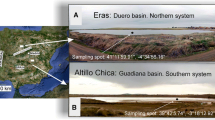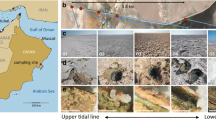Abstract
This is the first study of the highest elevation cyanobacteria-dominated microbial mat yet described. The desiccated mat was sampled in 2010 from an ephemeral rock pool at 5500 m above sea level in the Cordillera Vilcanota of southern Perú. After being frozen for 6 years at −20 °C in the lab, pieces of the mat were sequenced to fully characterize both the 16 and 18S microbial communities and experiments were conducted to determine if organisms in the mat could revive and become active under the extreme freeze–thaw conditions that these mats experience in the field. Sequencing revealed an unexpectedly diverse, multi-trophic microbial community with 16S OTU richness comparable to similar, seasonally desiccated mats from the Dry Valleys of Antarctica and low elevation sites in the Atacama Desert region. The bacterial community of the mat was dominated by phototrophs in the Cyanobacteria (Nostoc) and the Rhodospirillales, whereas the eukaryotic community was dominated by predators such as bdelloid rotifers (Philodinidae). Microcosm experiments showed that bdelloid rotifers in the mat were able to come out of dormancy and actively forage even under realistic field conditions (diurnal temperature fluctuations of −12 °C at night to + 27 °C during the day), and after being frozen for 6 years. Our results broaden our understanding of the diversity of life in periodically desiccated, high-elevation habitats and demonstrate that extreme freeze–thaw cycles per se are not a major factor limiting the development of at least some members of these unique microbial mat systems.






Similar content being viewed by others
References
Alpert P (2006) Constraints of tolerance: why are desiccation-tolerant organisms so small or rare? J Exp Biol 209:1575–1584
Brown MW, Silberman JD, Spiegel FW (2012) A contemporary evaluation of the acrasids (Acrasidae, Heterolobosea, Excavata). Eur J Protistol 48:103–123
Buffen AM, Thompson LG, Mosley-Thompson E, Huh KI (2009) Recently exposed vegetation reveals Holocene changes in the extent of the Quelccaya Ice Cap, Perú. Quat Res 72:157–163
Caporaso JG, Kuczynski J, Stombaugh J, Bittinger K, Bushman FD, Costello EK (2010) QIIME allows analysis of high-throughput community sequencing data. Nat Methods 7:335–336
Caporaso JG, Lauber CL, Walters WA, Berg-Lyons D, Huntley J et al (2012) Ultra-high-throughput microbial community analysis on the Illumina HiSeq and MiSeq platforms. ISME J 6:1621–1624
CONDESAN (2012) Biodiversidad y cambio climático en los Andes tropicales (eds Cuesta F, Muriel P, Beck S, Meneses RI, Halloy S, Salgado S, Ortiz E, Becerra MT). Red Gloria-Andes., Lima, 180 pp
Csotonyi JT, Swiderski J, Stackebrandt E, Yurkov V (2010) A new environment for anoxygenic phototrophic bacteria: biological soil crusts. Environ Microbiol Rep doi:10.1111/j.1758-2229.2010.00151.x
Cuesta F, Muriel P, Llambí LD, Halloy S, Aguirre N, Beck S, Carilla J, Meneses RI, Cuello S, Grau A, Gámez LE, Irazábal J, Jácome J, Jaramillo R, Ramírez L, Samaniego N, Suárez-Duque D, Thompson N, Tupayachi A, Viñas P, Yager K, Becerra MT, Pauli H, Gosling WD (2016) Latitudinal and altitudinal patterns of plant community diversity on mountain summits across the tropical Andes. Ecography. doi:10.1111/ecog.02567
Curtis BA, G Tanifuji G, Burki F et al (2012) Algal genomes reveal evolutionary mosaicism and the fate of nucleomorphs. Nature 492:59–65
Demergasso C, Dorador C, Meneses D, Blamey J, Cabrol N, Escudero L, Chong G (2010) Prokaryotic diversity patterns in high-altitude ecosystems of the Chilean Altiplano. J Geophys Res 115:G00D09
Esposito RME, Horn SL, McKnight DM, Cox MJ, Grant MC, Spaulding SA, Doran PT, Cozzetto KD (2006) Antarctic climate cooling and response of diatoms in glacial meltwater streams. Geophys Res Lett 33:L07406
Farías ME, Rascovan N, Toneatti DM, Albarracín VH, Flores MR, Poiré DG et al (2013) The Discovery of Stromatolites developing at 3570 m above sea level in a high-altitude volcanic Lake Socompa, Argentinean Andes. PLoS ONE 8:e53497. doi:10.1371/journal.pone.0053497
Feng Y-N, Zhang Z-C, Feng J-L, Qiu B-S (2012) Effects of UV-B radiation and periodic desiccation on the morphogenesis of the edible terrestrial cyanobacterium Nostoc flagelliforme. Appl Environ Microbiol 78:7075–7081
Fernandez AB, Rasuk MC, Visscher PT, Contreras M, Novoa F, Poire DG, Patterson MM, Ventosa A, Farias ME (2016) Microbial diversity in sediment ecosystems (evaporites domes, microbial mats, and crusts) of hypersaline Laguna Tebenquiche, Salar de Atacama, Chile. Frontiers. Microbiology. doi:10.3389/fmicb.2016.01284
Friedmann EI (1982) Endolithic microorganisms in the Antarctic cold desert. Science 215:1045–1053
Gao KS, Ye CP (2003) Culture of the terrestrial cyanobacterium Nostoc flagelliforme (Cyanophyceae) under aquatic conditions. J Phycol 39:617–623
Gottfried M, Pauli H, Futschik A, Akhalkatsi M et al (2012) Continent-wide response of mountain vegetation to climate change. Nature Climate Change 2:111–115
Halloy S, Seimon A, Yager K (2006) Multidimensional (climate, biodiversity, socioeconomics, agriculture) context of changes in land use in the Vilcanota watershed, Peru. In: Spehn E, Liberman-Cruz M, Körner C (eds) Land use change and mountain biodiversity. Ft. CRC Press, Lauderdale, pp 323–337
Halloy S, Yager K, García C, Beck S (2010) South America: Climate monitoring and adaptation integrated across regions and disciplines. In J. Settele (Ed.), Atlas of biodiversity risk- from Europe to the globe, from stories to maps. Pensoft:Sofia and Moscow.
Hawes I, Howard-Williams C, Vincent WF (1992) Desiccation and recovery of Antarctic cyanobacterial mats. Polar Biol 12:587–594
James TY et al (2006) Molecular phylogeny of the flagellated fungi (Chytridiomycota) and description of a new phylum (Blastocladiomycota). Mycologia 98:860–871
Johnson HE, Kinga SR, Banacka SA, Webster C, Callanaupa WJ, Coxa PA (2008) Cyanobacteria (Nostoc commune) used as a dietary item in the Peruvian highlands produce the neurotoxic amino acid BMAA. J Ethnopharmacol 118:159–165
King AJ, Freeman KR, Lozupone CA, Knight R, Schmidt SK (2010a) Biogeography and habitat modelling of high-alpine bacteria. Nature Commun 1:53 doi:10.1038/ncomms1055
King AJ, Karki D, Nagy L, Racoviteanu A, Schmidt SK (2010b) Microbial biomass and activity in high elevation soils of the Annapurna and Sagarmatha regions of the Nepalese Himalayas. Himal J Sci doi:10.3126/hjs.v6i8.2303
Knelman JE, Schmidt SK, Darcy JL, Castle SC et al (2014) Nutrient addition dramatically accelerates microbial community succession. PLoS ONE 9:e102609
Lynch R, King AJ, Farías ME, Sowell P, Vitry C, Schmidt SK (2012) The potential for microbial life in the highest elevation (>6000 m.a.s.l.) mineral soils of the Atacama region. J Geophys Res 117:G02028
Madigan MT (1988) Microbiology, physiology, and ecology of phototrophic bacteria. In: Zehnder AJB (ed) Biology of anaerobic microorganisms. John Wiley, New York, pp 39–111
Marshall S (2014) Glacier retreat crosses a line. Science 345:872–873
Marzeion B, Cogley JG, Richter K, Parkes D (2014) Attribution of global glacier mass loss to anthropogenic and natural causes. Science 345:919–921
McKnight DM, Niyogi DK, Alger AS, Bomblies A, Conovitz PA, Tate CM (1999) Dry valley streams in Antarctica: ecosystems waiting for water. Bioscience 49:985–995
Mladenov N, Williams, MW, Schmidt SK, Cawley K (2012) Atmospheric deposition as a source of carbon and nutrients to an alpine catchment of the Colorado Rocky Mountains. Biogeosciences 9:3337–3355
Naff CS, Darcy JL, Schmidt SK. (2013) Phylogeny and biogeography of an uncultured clade of Snow Chytrids. Environ Microbiol 15:2672–2680
Nemergut DR, Anderson SP, Cleveland CC, Martin AP, Miller AE, Seimon A, Schmidt SK (2007) Microbial community succession in unvegetated, recently-deglaciated soils. Microb Ecol 53:110–122
Newsham KK, Maslen NR, McInnes SJ (2006) Survival of antarctic soil metazoans at− 80 C for six years. CryoLetters 27(5): 291–294
Onofri S, Barreca D, Selbmann L, Isola D, Rabbow E, Horneck G, De Vera JPP, Hatton J, Zucconi L (2008) Resistance of antarctic black fungi and cryptoendolithic communities to simulated space and Martian conditions. Stud Mycol 61:99–109
Porazinska DL, Fountain AG, Nylen TH, Tranter M, Virginia RA, Wall DH (2004) The biodiversity and biogeochemistry of cryoconite holes from McMurdo Dry Valley glaciers, Antarctica. Arct Antarct Alp Res 36:84–91
Rabatel A, Francou B, Soruco A et al. (2013) Current state of glaciers in the tropical Andes: a multi-century perspective on glacier evolution and climate change. Cryosphere 7:81–102
Ragatz L, Jiang Z-Y, Bauer CE, Gest H (1995) Macroscopic phototactic behavior of the purple photosynthetic bacterium Rhodospirillum centenum. Arch Microbiol 162:1–6
Rasuk MC, Fernández AB, Kurth D, Contreras M, Novoa F, Poiré D, Farías ME (2016) Bacterial diversity in microbial mats and sediments from the Atacama Desert. Microb Ecol 71:44–56
Reddy GSN, Garcia-Pichel F (2007) Sphingomonas mucosissima sp. nov. and Sphingomonas desiccabilis sp. nov., from biological soil crusts in the Colorado Plateau, USA. Int J Syst Evol Microbiol 57:1028–1034
Robeson MS, Costello EK, Freeman KR, Whiting J, Adams B, Martin AP, Schmidt SK (2009) Environmental DNA sequencing primers for eutardigrades and bdelloid rotifers. BMC Ecol. doi:10.1186/1472-6785-9-25
Robeson MS, King AJ, Freeman KR, Birky CW, Martin AP, Schmidt SK (2011) Soil rotifer communities are extremely diverse globally but spatially autocorrelated locally. Proc Natl Acad Sci USA 108:4406–4410
Schmidt SK, Darcy JL (2015) Phylogeography of ulotrichalean soil algae from extreme high-altitude and high-latitude ecosystems. Polar Biol 38:689–697
Schmidt SK, Sobieniak-Wiseman LC, Kageyama SA, Halloy SRP, Schadt CW (2008) Mycorrhizal and dark-septate fungi in plant roots above 4270 meters elevation in the Andes and Rocky Mountains. Arct Antarct Alp Res 40:576–583
Schmidt SK, Nemergut DR, Miller AE AE, Freeman KR, King AJ, Seimon A (2009) Microbial activity and diversity during extreme freeze-thaw cycles in periglacial soils, 5400 m elevation, Cordillera Vilcanota, Perú. Extremophiles 13:807–816
Schmidt SK, Lynch R, King AJ, Karki D, Robeson MS, Nagy L, Freeman KR (2011) Phylogeography of microbial phototrophs in the dry valleys of the high Himalayas and Antarctica. Proc Roy Soc B 278:702–708
Schmidt SK, Nemergut DR, Todd BT, Darcy JL, Cleveland CC, King AJ (2012) A simple method for determining limiting nutrients for photosynthetic crusts. Plant Ecol Diversity 5:513–519
Seimon A, Yager K, Seimon T, Schmidt SK, Grau A, Beck S, García C, Tupayachi A, Sowell P, Touval J, Halloy SRP (2009) Changes in biodiversity patterns in the High Andes - Understanding the consequences and seeking adaptation to global change. Mt Forum Bull 9:25–27
Smith HG, Hughes J, Moore SJ (1990) Growth of Antarctic and temperate terrestrial Protozoa under fluctuating temperature regimes. Antarctic Sci 2:313–320
Staley JT, Palmer F, Adams JB (1982) Microcolonial fungi: common inhabitants on desert rocks? Science 215:1093–1095
Stanish LF, O’Neill SP, Gonzalez A, Legg TM, Knelman J, McKnight DM, Spaulding S, Nemergut DR (2013) Bacteria and diatom co-occurrence patterns in microbial mats from polar desert streams. Environ Microbiol 15:1115–1131
Swan LW (1992) The Aeolian biome, ecosystems of the Earth’s extremes. Bioscience 42:262–270
Takishita K, Miyake M, Kawato M, Maruyama T (2005) Genetic diversity of microbial eukaryotes in anoxic sediment around fumaroles on a submarine caldera floor based on the small-subunit rDNA phylogeny. Extremophiles 9:185–196
Thompson LG et al (2013) Annually resolved ice core records of tropical climate variability over the past ~ 1800 Years. Science 340:945–950
Vimercati L, Hamsher S, Schubert Z, Schmidt SK (2016) Growth of high-elevation Cryptococcus sp. during extreme freeze-thaw cycles. Extremophiles 20:579–588
Walochnik J, Mulec J (2009) Free-living Amoebae in carbonate precipitating microhabitats of karst caves and a new vahlkampfiid amoeba Allovahlkampfia spelaea gen. nov., sp. nov. Acta Protozool 48:25–33
Yang M, Yao T, Gou X, Koike T, He Y (2002) The soil moisture distribution, thawing-freezing processes and their effects on the seasonal transition on the Qinghai–Xizang (Tibetan) plateau. J Asian Earth Sci 21:457–465
Zeglin LH, Dahm CN, Barrett JE, Gooseff MN, Fitpatrick S, Takacs-Vesbach CD (2011) Bacterial community structure along moisture gradients in the parafluvial sediments of two ephemeral desert streams. Microb Ecol 61:1–14
Acknowledgements
We thank A.J. King, R.I. Meneses, and A. Seimon for their assistance in the field; and A.J. Solon, L. Vimercati, J. Henley, and N. Fierer for their laboratory assistance and advice about DNA sequencing. Funding was provided by NSF Grants DEB-1258160 and DEB-1457827, and a grant from the National Geographic Society.
Author information
Authors and Affiliations
Corresponding author
Additional information
Communicated by A. Oren.
Electronic supplementary material
Below is the link to the electronic supplementary material.
Rights and permissions
About this article
Cite this article
Schmidt, S.K., Darcy, J.L., Sommers, P. et al. Freeze–thaw revival of rotifers and algae in a desiccated, high-elevation (5500 meters) microbial mat, high Andes, Perú. Extremophiles 21, 573–580 (2017). https://doi.org/10.1007/s00792-017-0926-2
Received:
Accepted:
Published:
Issue Date:
DOI: https://doi.org/10.1007/s00792-017-0926-2




